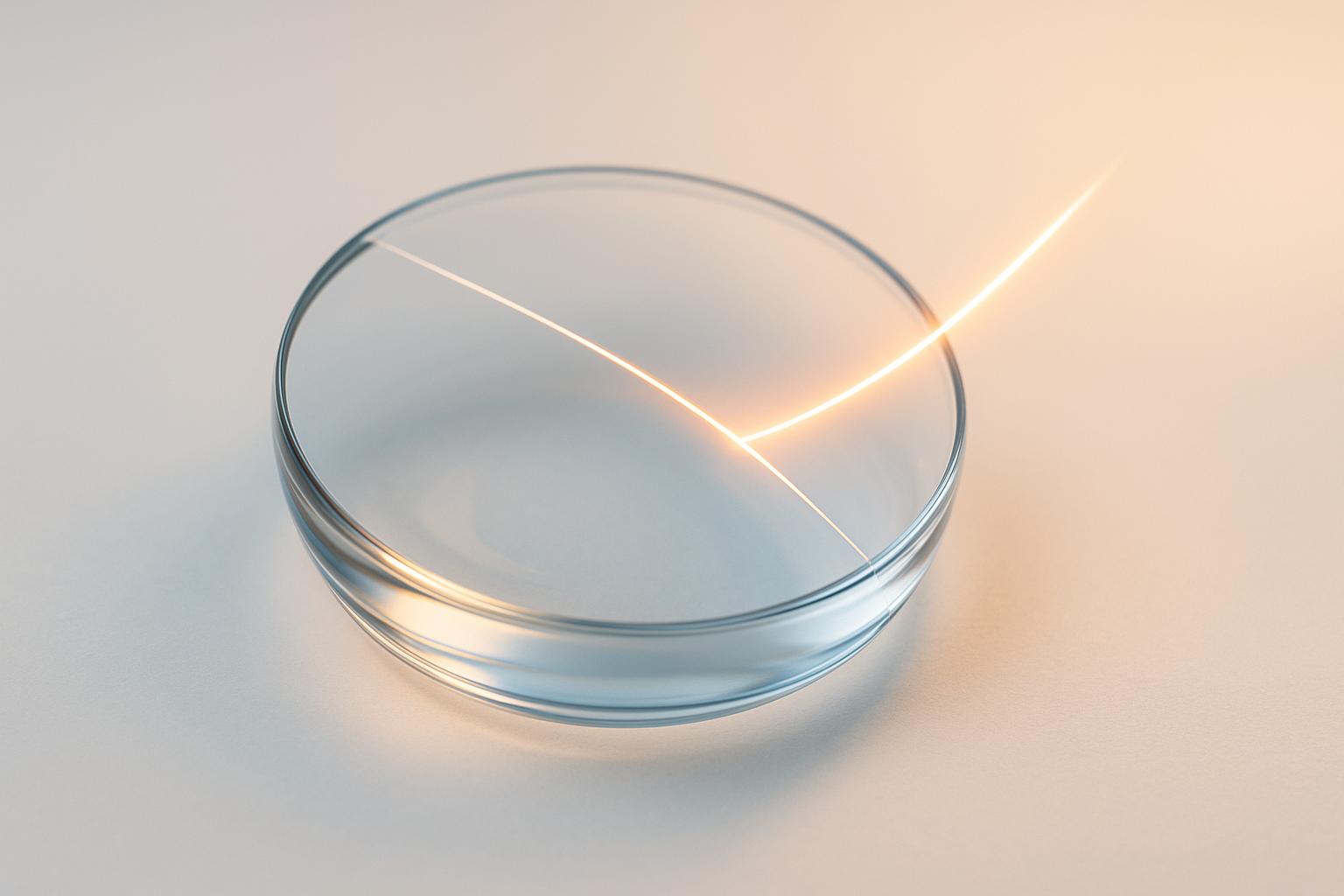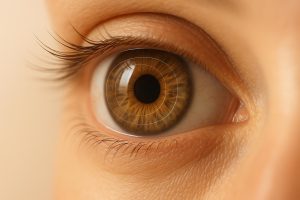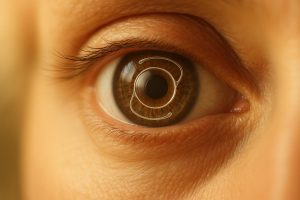Wavefront LASIK offers a precise, tailored approach to vision correction by using a detailed 3D map of your eye’s unique imperfections. Unlike standard LASIK, it corrects both common vision issues and subtle distortions like halos and glare. Here’s why it stands out:
- Higher Precision: Adjusts vision with 0.01 diopter accuracy, compared to 0.25 diopters in standard LASIK.
- Better Results: 98% of patients achieve 20/20 vision or better, with 56% reaching sharper-than-perfect 20/12.5 vision.
- Improved Night Vision: Reduces issues like glare and halos, enhancing contrast sensitivity for low-light conditions.
- Personalized Treatment: Uses advanced mapping to address both lower- and higher-order aberrations, ensuring customized corrections.
Wavefront LASIK is particularly effective for those with complex prescriptions, astigmatism, or larger pupils. With advanced eye-tracking systems ensuring precision, it delivers sharper, clearer vision and high satisfaction rates.
What is wavefront, and is it better than conventional laser eye surgery?
How Wavefront Technology Maps Eye Imperfections
Wavefront technology uses a safe, low-power laser to create a detailed 3D map of your eye, uncovering even the tiniest imperfections. During the process, an aberrometer directs the laser beam through your eye, passing through the cornea and lens before reflecting off the retina. As the beam exits, any distortions caused by microscopic irregularities are measured. This data is then used to generate a three-dimensional map that identifies over 200 unique aberrations – pinpointing issues that traditional eye exams might miss. This precise mapping helps differentiate between various types of aberrations.
Additionally, this technology can detect subtle irregularities responsible for issues like halos, glare, and reduced contrast.
Lower-Order vs. Higher-Order Aberrations
Using the detailed map, wavefront technology classifies aberrations into two main categories. Lower-order aberrations include common vision problems such as myopia (nearsightedness), hyperopia (farsightedness), and astigmatism. These are typically corrected with glasses, contact lenses, or standard LASIK procedures.
Higher-order aberrations, on the other hand, are more complex and can lead to visual disturbances like halos around lights, glare, and poor night vision. These subtle issues cannot be corrected with traditional methods. Research shows that 88% of patients experience improved contrast sensitivity after wavefront-guided LASIK, compared to only 40% with standard LASIK. Higher-order aberrations include conditions like coma, trefoil, and spherical aberration, which can make activities like night driving particularly challenging.
Advanced Eye-Tracking Systems
To ensure precision during the procedure, advanced eye-tracking systems are used to compensate for involuntary eye movements that could misalign the laser. These systems continuously monitor your eye’s position in real time by tracking infrared-reflected reference points, such as the pupil center and unique iris patterns. If your eye shifts significantly, the laser automatically pauses until alignment is restored.
This meticulous tracking ensures that each laser pulse is delivered to the exact intended spot on your cornea. Thanks to this precision, studies show that 96.15% of eyes achieve a spherical equivalent within ±1.00 diopter of the target, and 92.31% fall within ±0.50 diopter after wavefront-guided LASIK.
Benefits of Wavefront-Guided LASIK Over Standard LASIK
Wavefront-guided LASIK takes vision correction to the next level by refining adjustments down to an impressive 0.01 diopters – far surpassing the 0.25 diopter limit of standard LASIK treatments. This level of precision results in sharper, crisper vision for patients.
Precision and Personalization
What sets wavefront-guided LASIK apart is its ability to create a highly detailed map of the eye, addressing both lower- and higher-order aberrations. Standard LASIK, by comparison, focuses on broader corrections and often falls short when it comes to fixing complex visual imperfections. Patients with higher prescriptions, significant astigmatism, or larger pupils often see the greatest benefits from this tailored approach. The result? A personalized treatment plan that significantly improves overall visual clarity.
Superior Visual Outcomes
Wavefront-guided LASIK doesn’t just stop at precision – it delivers exceptional visual results. Clinical studies show that 56% of patients treated with wavefront-guided LASIK achieve 20/12.5 vision or better, compared to 41% with wavefront-optimized treatments. Many patients even surpass the standard 20/20 benchmark, enjoying vision that feels almost superhuman.
Here’s how the outcomes stack up:
| Visual Outcome Measure | Wavefront-Guided LASIK | Standard LASIK |
|---|---|---|
| 20/12.5 or better vision | 56% | 41% |
| Predictability (±0.50 D) | 92.31% | 87% |
| Contrast sensitivity improvement | 88% | 40% |
| Night vision performance loss | 0–3% | Not specified |
One standout feature is the improvement in contrast sensitivity: 88% of wavefront-guided LASIK patients experience better contrast sensitivity, compared to just 40% with standard LASIK. This means clearer vision in all kinds of lighting, whether it’s bright daylight or dim settings.
Night vision also sees a dramatic improvement. With wavefront-guided LASIK, only 0–3% of patients report any loss in night vision performance. By correcting higher-order aberrations like coma and trefoil, the treatment reduces common nighttime issues such as glare and halos, making activities like night driving much easier.
Patient satisfaction speaks volumes, with over 97% of wavefront-guided LASIK patients reporting results that often exceed what they achieved with glasses or contact lenses. For those with complex visual needs or anyone seeking top-tier correction, wavefront-guided LASIK provides a clear advantage. At Boulder Eye Surgeons, this advanced technology is tailored to meet your unique vision requirements.
sbb-itb-c87b093
Wavefront-Guided vs. Wavefront-Optimized LASIK
Both wavefront-guided and wavefront-optimized LASIK aim to enhance traditional LASIK by offering improved precision and outcomes. However, they differ in how they customize treatments, making it essential to understand these distinctions when considering which option aligns with your vision needs.
Wavefront-guided LASIK takes customization to the next level by creating a detailed 3D map of your optical system. This map captures a complete profile of your eye’s aberrations, allowing for highly personalized corrections. Essentially, the laser treatment is tailored to address your unique visual imperfections, delivering a level of precision that sets it apart.
On the other hand, wavefront-optimized LASIK focuses on correcting standard refractive errors like nearsightedness, farsightedness, and astigmatism. It uses pre-set laser patterns designed to minimize spherical aberrations, but it doesn’t target higher-order aberrations with the same level of detail as wavefront-guided LASIK.
One notable difference is the precision of correction. Wavefront-guided LASIK can adjust vision with 0.01 diopter accuracy – 25 times finer than the 0.25 diopter increments used in wavefront-optimized LASIK.
Comparison of Techniques
Here’s a quick look at how these two approaches stack up:
| Characteristic | Wavefront-Guided LASIK | Wavefront-Optimized LASIK |
|---|---|---|
| Measurement Precision | 0.01 diopters | 0.25 diopters |
| Correction Approach | Addresses both higher- and lower-order aberrations | Targets spherical aberrations and standard refractive errors |
| Best Suited For | Complex aberrations, higher prescriptions, or larger pupils | Standard refractive errors |
| Visual Acuity (20/12.5 or better) | 56% of patients | 41% of patients |
| Contrast Sensitivity Improvement | 88% improvement | 40% improvement |
| Night Vision Performance Loss | 0–3% | Not specifically reported |
| Predictability (within ±0.50 D) | 92.31% | 87% |
| Patient Satisfaction | >97% | >97% |
Wavefront-guided LASIK is particularly effective for patients dealing with higher prescriptions, significant higher-order aberrations (like coma or trefoil), or issues such as poor night vision and glare when wearing glasses or contacts. Studies show that 56.3% of patients undergoing this technique gained one or more lines of corrected distance visual acuity, compared to 43.7% of those treated with wavefront-optimized LASIK.
Meanwhile, wavefront-optimized LASIK is an excellent choice for individuals with standard refractive errors and minimal higher-order aberrations. It offers reliable results, a strong safety profile, and may be more cost-effective for those who don’t need the advanced customization of wavefront-guided treatment.
Ultimately, choosing the right LASIK approach depends on your unique vision profile. At Boulder Eye Surgeons, every patient undergoes a thorough pre-surgical evaluation, including a detailed wavefront analysis. This ensures the recommended treatment is tailored to your eye structure and vision goals, maximizing both visual outcomes and satisfaction.
The Personalized Treatment Process
Wavefront-guided LASIK takes a tailored approach, crafting treatment plans that match the unique characteristics of your eyes. This process begins with a thorough evaluation and continues seamlessly through the procedure itself.
From Mapping to Surgery
The journey starts with an in-depth pre-surgical evaluation. Your eye care team will review your medical history, lifestyle, and current vision needs to ensure the treatment aligns with your goals and circumstances.
At the core of this approach is wavefront mapping, achieved using an aberrometer. This advanced device sends a low-power laser beam into your eye, measuring how the light reflects back. The result? An optical fingerprint that identifies every imperfection in your eye’s visual system, from common refractive errors to more subtle higher-order aberrations .
This analysis creates a detailed, three-dimensional map of how light travels through your eye, pinpointing areas that require correction. This data enables unparalleled precision, ensuring the laser treatment is customized to your specific needs.
Once your personalized eye map is complete, the excimer laser is programmed with this data. The laser’s ablation pattern is fine-tuned to address both lower-order and higher-order aberrations, ensuring the reshaping of your cornea is as precise as possible. This tailored approach continues seamlessly into the surgical phase.
During the surgery itself, real-time eye tracking ensures the laser remains aligned with your personalized map, even if your eye moves during the procedure .
Achieving Optimal Outcomes
Thanks to this detailed customization, wavefront-guided LASIK delivers outstanding visual results. Clinical studies show that this approach achieves exceptional refractive accuracy.
Many patients experience vision sharper than 20/20. In fact, about 56% of eyes treated with wavefront-guided LASIK achieve 20/12.5 vision or better – far exceeding the standard for "perfect" vision. This is a significant improvement compared to the 41% of patients who achieve similar results with wavefront-optimized treatments.
Additionally, this method enhances contrast sensitivity and night vision. Studies report an 88% increase in contrast sensitivity, helping patients see clearly in low-light conditions. Only 0–3% of patients experience any reduction in night vision performance.
The benefits extend beyond sharper vision. Patients overwhelmingly report high satisfaction rates – over 97% – with many stating that their vision after surgery surpasses what they achieved with glasses or contact lenses, especially in dim lighting.
At Boulder Eye Surgeons, this personalized approach ensures that every patient receives a treatment plan designed specifically for their eye structure and vision goals. By combining advanced wavefront mapping, precise laser programming, and real-time tracking, the procedure maximizes visual outcomes while minimizing risks.
Wavefront-guided LASIK is particularly effective for individuals with complex prescriptions, higher-order aberrations, or larger pupils. By addressing your eye’s complete optical profile – not just basic refractive errors – this method offers one of the most comprehensive vision correction solutions available today.
Conclusion: Better Vision with Wavefront LASIK
Wavefront-guided LASIK brings a cutting-edge approach to vision correction, designed to match the unique characteristics of your eyes. Unlike glasses or contact lenses, this technology targets visual imperfections with precision, offering a clearer, sharper view of the world.
Studies show that most patients achieve outstanding results with wavefront-guided LASIK, with over 97% expressing high satisfaction. Beyond just clearer vision, it enhances contrast sensitivity and improves night vision, making it easier to navigate dimly lit environments or drive after dark. This makes it an excellent option for individuals with more complex prescriptions, larger pupils, or higher-order aberrations.
Given these advantages, selecting a provider equipped with advanced wavefront technology is essential. Boulder Eye Surgeons offers a range of laser vision correction services, including wavefront-guided LASIK, with a focus on creating personalized treatment plans tailored to your specific needs. Discover the difference of clearer, crisper vision – schedule a consultation today by visiting bouldereyesurgeons.com.
FAQs
What’s the difference between wavefront-guided and wavefront-optimized LASIK, and how can I choose the best option for me?
Wavefront-guided LASIK and wavefront-optimized LASIK both reshape the cornea to improve vision, but they take different approaches to correcting imperfections. Wavefront-guided LASIK creates a highly detailed, personalized map of your eye to address unique irregularities, including higher-order aberrations that can impact night vision and contrast sensitivity. In contrast, wavefront-optimized LASIK focuses on maintaining the eye’s natural corneal shape while correcting common vision problems like nearsightedness, farsightedness, and astigmatism.
Choosing the right procedure depends on factors such as your eye health, the severity of your vision issues, and your daily activities. Consulting with an experienced LASIK provider, like Boulder Eye Surgeons, can help you identify the best option for your specific needs. With advanced technology and individualized care, they aim to deliver precise and effective treatments tailored to you.
How does wavefront-guided LASIK enhance night vision and reduce glare or halos compared to traditional LASIK?
Wavefront-guided LASIK takes night vision to the next level by addressing common issues like glare and halos. It uses cutting-edge technology to create a highly detailed map of your eye, pinpointing even the smallest imperfections in the cornea. This tailored approach allows the laser to correct irregularities that standard LASIK might miss.
By focusing on these precise details, wavefront-guided LASIK delivers clearer, sharper vision, particularly in low-light settings. Many patients notice fewer problems with night vision and experience a marked decrease in glare and halos after undergoing the procedure.
How does wavefront-guided LASIK correct vision more precisely than standard LASIK?
Wavefront-guided LASIK employs cutting-edge technology to generate a detailed 3D map of your eye, capturing its unique imperfections. Unlike standard LASIK, this method addresses higher-order aberrations – subtle visual issues that can cause problems like glare, halos, or trouble seeing in low-light conditions.
By customizing the procedure to the specific characteristics of your eye, wavefront-guided LASIK enhances vision clarity and sharpness. This tailored approach corrects even minor irregularities in the cornea, leading to improved visual quality and often surpassing the results of traditional LASIK.





